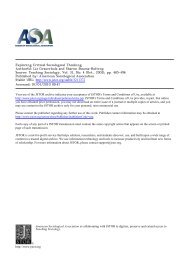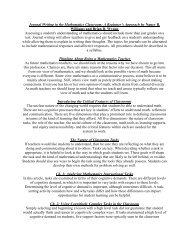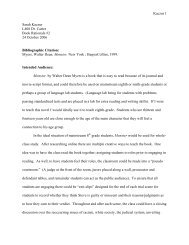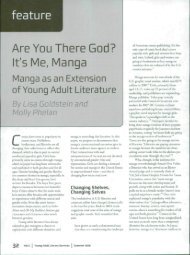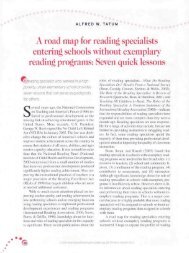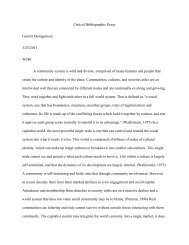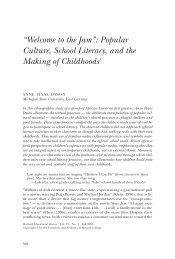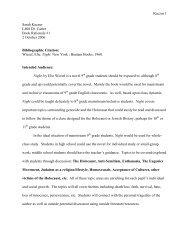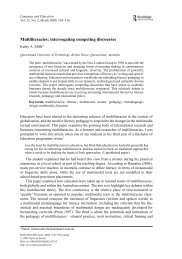Dressman 2009 New lit editor overview.pdf - Oncourse
Dressman 2009 New lit editor overview.pdf - Oncourse
Dressman 2009 New lit editor overview.pdf - Oncourse
Create successful ePaper yourself
Turn your PDF publications into a flip-book with our unique Google optimized e-Paper software.
<strong>Dressman</strong>, McCarthey, and Prior Editors’ Introduction 345<br />
Editors’ Introduction: Adolescents’ Literacy and the Promises of<br />
Digital Technology<br />
Mark <strong>Dressman</strong><br />
Sarah McCarthey<br />
Paul Prior<br />
University of Illinois at Urbana-Champaign<br />
Over the last fifteen years, nothing in research or theory has been heralded as a<br />
greater boon to the development of adolescents’ <strong>lit</strong>eracy practices than the advent<br />
of personal computing and the Internet. Based on a combination of studies of<br />
semiotics, popular culture, and social and cultural production and reproduction,<br />
researchers in secondary <strong>lit</strong>eracy have mainly studied the practices of individuals<br />
and small groups of adolescents, and have used the findings from these studies to<br />
argue two related points (Alvermann, Hinchman, Moore, Phelps, & Waff, 2006;<br />
Chandler-Olcott, 2007; Gee, 2000; Kress, 2003; Lankshear & Knobel, 2006; Lewis<br />
& Fabos, 2005; <strong>New</strong> London Group, 1996). First, these studies have found that in<br />
marked contrast to conventional measures of in-school <strong>lit</strong>eracy which find that<br />
many adolescents struggle to read and write with efficacy, when <strong>lit</strong>eracy is digitized<br />
and made personally and socially empowering, adolescents become highly engaged<br />
and excel as readers and writers across a broad range of print- and image-based<br />
formats. The second point, which builds from the first, is to emphasize the stark<br />
contrast between the print-centric curriculum of conventional secondary schools<br />
and the multimoda<strong>lit</strong>y of contemporary workplaces and everyday life, and to<br />
argue that in their <strong>lit</strong>erate practices many adolescents today seem to be anticipating<br />
and preparing for lives of work and play that leave the traditional practices of<br />
schooling far behind.<br />
The three research studies and the Standpoints essay featured in this issue<br />
of Research in the Teaching of English both contribute to and challenge current<br />
perspectives on relations between digital technology and the development of<br />
adolescent <strong>lit</strong>eracy in the early twenty-first century. David Bruce’s study, “Writing<br />
with Visual Images: Examining the Video Composition Processes of High School<br />
Students,” builds on models of written composition such as those of Emig (1977)<br />
and Flower and Hayes (Flower, 1989; Flower & Hayes, 1981) to argue for a model<br />
of video composition that stresses the recursive and self-evaluative nature of the<br />
composition process even more than researchers of writing have. Bruce grounds<br />
his model in a study of three small groups of high school students as they planned,<br />
Research in the Teaching of English Volume 43, Number 4, May <strong>2009</strong> 345
346 Research in the Teaching of English Volume 43 May <strong>2009</strong><br />
videotaped, and edited a music video based on a song of their choosing. His study<br />
also provides a vivid and candid account of the logistical and pedagogical challenges<br />
faced by teachers and researchers who teach composition through multimoda<strong>lit</strong>y<br />
within a high school setting.<br />
A second study by Rebecca Black, “Online Fan Fiction, Global Identities, and<br />
Imagination,” similarly draws on three case studies, in this instance of three young<br />
Asian women located in different countries along the Pacific Rim (Canada and the<br />
Philippines), to document the role of fan fiction sites as a means of developing<br />
proficiency in English-language discourses. However, based on theories of global<br />
cultural exchange (e.g., Appadurai, 1996), Black argues that far from merely acquiring<br />
proficiency in English, in their practices of appropriating language, images, and<br />
fictional elements from a wide range of Asian and international sources, publishing<br />
their fiction on the World Wide Web, and then engaging readers around the world<br />
in critical discussions of their compositions, these women are participating in a<br />
process whereby new genres are changing modes of English-based expression and<br />
broadening the avenues through which transnational, transcultural communication<br />
across individuals and groups occurs.<br />
The third study in this issue and the featured Standpoints essay take more<br />
circumspect positions with regard to the promises of digital technology. In “Changing<br />
Conceptions and Uses of Computer Technologies in the Everyday Literacy<br />
Practices of Sixth and Seventh Graders,” Jane Agee and Jeanette Altarriba report<br />
findings from a survey of 189 early adolescents in a middle-class, predominantly<br />
white school district and show that early adolescents in their study were not nearly<br />
as engaged or preoccupied with computer technology as might be presumed from<br />
case studies of similar populations. They suggest that these students’ developmental<br />
status (seventh graders reported more online computer use than sixth graders),<br />
limited technology use within the schools, and differences in <strong>lit</strong>erate proficiency<br />
may help to account for this discrepancy. These findings add some nuance to<br />
current discussions of the role of technology in the lives of adolescents and point<br />
to specific factors that may limit the extent to which adolescents embrace digital<br />
<strong>lit</strong>eracy as a part of their daily lives.<br />
Elizabeth Moje argues for an even more nuanced and reflexive approach to<br />
the study of adolescents’ use of digital technology in her featured Standpoints<br />
essay for this issue, “A Call for <strong>New</strong> Research in <strong>New</strong> and Multi-Literacies.” Moje<br />
opens her essay by noting that the extent to which digital forms of <strong>lit</strong>eracy influence<br />
daily lives may vary broadly across individuals. But she also points out that<br />
much of the information in these new modes remains encoded in conventional<br />
print, and suggests whether a complete rupture with pre-digital forms of <strong>lit</strong>eracy<br />
has occurred or whether the incorporation of hypertext, audio, and still and video<br />
images with print text might better be described as not completely “new,” but as<br />
a combination of new and old modes that are compositionally wide-ranging. If<br />
this is the case, then distinctions among digital formats, the practices that develop
<strong>Dressman</strong>, McCarthey, and Prior Editors’ Introduction 347<br />
from each, and the cognitive outcomes that are produced from them must be<br />
delineated and researched. <strong>New</strong>/old questions about relationships among quantity<br />
and qua<strong>lit</strong>y of access to digital tools in and out of school and their effects on<br />
learning and school achievement must also be asked, and ways of researching<br />
that not only document the processes and social and cultural effects of digital<br />
technology in the lives of individuals but that distinguish among differing effects<br />
across subgroups of students, different uses of media, and different pedagogical<br />
and curricular approaches must be developed. In short, Moje’s essay is a call for<br />
researchers to move beyond the documentation and theorization of digital <strong>lit</strong>eracy<br />
as a new, or novel, phenomenon, and to view it instead as an integral feature of<br />
how digital and other media are now combining to reshape what it means to be<br />
<strong>lit</strong>erate, particularly within educational contexts.<br />
In summary, we believe the studies and essay featured in this issue of RTE<br />
provide a snapshot representation of the current state and future possibi<strong>lit</strong>ies of<br />
research into adolescents’ <strong>lit</strong>erate uses of digital technology. Together, they push at<br />
the complexity—methodologically and theoretically—of research that addresses<br />
digital <strong>lit</strong>eracy and routine considerations of how digitization and conventional<br />
print <strong>lit</strong>eracy reciprocally affect each other. We are pleased to publish these studies<br />
and essay as an unofficial “themed” issue, and like Moje we call for additional research<br />
that approaches the phenomenon of digital <strong>lit</strong>eracy with rigor, systematicity,<br />
and theoretical and conceptual precision.<br />
References<br />
Alvermann, D. E., Hinchman, K., A., Moore,<br />
D. W., Phelps, S. F., & Waff, D. R. (2006).<br />
(Eds.), Reconceptualizing the <strong>lit</strong>eracies in<br />
adolescents’ lives (2nd ed.). Mahwah, NJ:<br />
Erlbaum.<br />
Appadurai, A. (1996). Modernity at large: Cultural<br />
dimensions of globalization. Minneapolis:<br />
University of Minnesota Press.<br />
Chandler-Olcott, K. (2007). Animé and<br />
manga fandom: Young people’s multi<strong>lit</strong>eracies<br />
made visible. In J. Flood, S. B. Heath &<br />
D. Lapp (Eds.), Research on teaching <strong>lit</strong>eracy<br />
through the communicative and visual arts<br />
(Vol. II, pp. 247–257). <strong>New</strong>ark, DE: International<br />
Reading Association.<br />
Emig, J. (1977). Writing as a mode of learning.<br />
College Composition and Communication, 28,<br />
122–128.<br />
Flower, L. (1989). Cognition, context, and<br />
theory building. College Composition and<br />
Communication, 40, 282–311.<br />
Flower, L., & Hayes, J.R. (1981). A cognitive<br />
process theory of writing. College Composition<br />
and Communication, 32, 365–87.<br />
Gee, J. (2000). Teenagers in new times: A<br />
new <strong>lit</strong>eracy studies perspective. Journal of<br />
Adolescent and Adult Literacy 43, 412–420.<br />
Kress, G. (2003). Literacy in the new media<br />
age. London: Routledge.<br />
Lankshear, C., & Knobel, M. (2006). <strong>New</strong> <strong>lit</strong>eracies:<br />
Everyday practices and classroom learning<br />
(2nd ed.). <strong>New</strong> York: Open University Press.<br />
Lewis, C., & Fabos, B. (2005). Instant messaging,<br />
<strong>lit</strong>eracies, and social identities. Reading<br />
Research Quarterly, 40, 470–501.<br />
<strong>New</strong> London Group. (1996). A pedagogy<br />
of multi<strong>lit</strong>eracies: Designing social futures.<br />
Harvard Educational Review, 66(1), 60–92.



